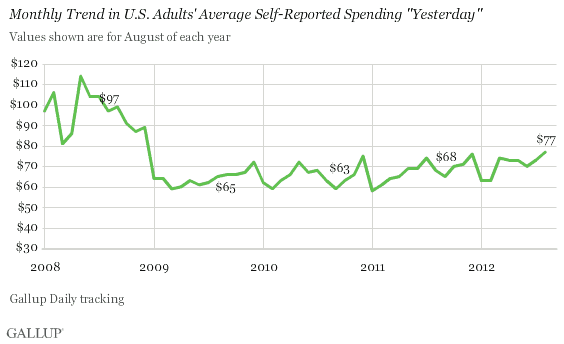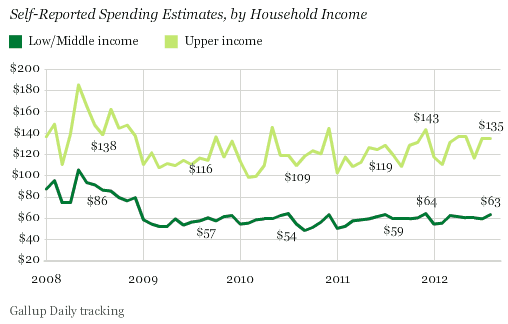WASHINGTON, D.C. -- Americans' self-reported daily spending averaged $77 in August, up from $73 in July, and the best August spending level recorded since 2008. It is also the highest average monthly spending since December 2008.

The results are based on Gallup Daily tracking from Aug. 1-31. Each night, Gallup asks Americans to report how much they spent the prior day apart from normal household bills or the purchase of a car or home.
Lower- and Middle-Income Consumer Spending Ticks Up
Spending among American households with annual incomes of $90,000 or less averaged $63 in August, up from $59 in July -- the highest level since December 2011. Upper-income spending, which has been on a generally upward trajectory so far in 2012, was unchanged in August, averaging $135 as it did in July.

That pattern is atypical; usually when spending increases in a given month it is driven by upper-income consumers rather than those with lower and middle incomes.
Although lower- and middle-income consumer spending increased in August, the yearly average for 2012 thus far -- $59 -- reveals that these groups' spending was still on par with 2011, when it averaged $58 for the year. Upper-income spending, however, is tracking ahead of 2011 levels, averaging $127 so far in 2012 compared with $121 for all of 2011.
Bottom Line
U.S. consumer spending climbed to its highest level is nearly four years in August 2012 at the same time that job creation appears to be improving. Gallup's Job Creation Index rose to +19 in August, up from +17 in July, and the payroll company Automatic Data Processing Inc., reported job gains last month that beat the consensus expectations. Additionally, Gallup's unadjusted unemployment rate was down in August, although the adjusted rate rose. Still, there may be other factors involved, including back-to-school spending.
The higher spending in 2012 to date is still coming more from higher-income Americans than from middle-class and lower-income households. Lower- and middle-income Americans did increase their spending slightly in August, but not enough to bring their average for the year above the levels seen in 2011. Further job market improvement could encourage this group to start spending more, but it will take a lot to get them to spend anywhere near what they did in early 2008, before the financial crisis.
Gallup.com reports results from these indexes in daily, weekly, and monthly averages and in Gallup.com stories. Complete trend data are always available to view and export in the following charts:
Daily: Employment, Economic Confidence, Job Creation, Consumer Spending
Weekly: Employment, Economic Confidence, Job Creation, Consumer Spending
Read more about Gallup's economic measures.
View our economic release schedule.
Survey Methods
Results are based on telephone interviews conducted as part of Gallup Daily tracking Aug. 1-31, 2012, with a random sample of 14,964 adults, aged 18 and older, living in all 50 U.S. states and the District of Columbia.
For results based on the total sample of national adults, one can say with 95% confidence that the maximum margin of sampling error is ±1 percentage points.
The estimates for average daily spending have a margin of sampling error of ±$4.
Interviews are conducted with respondents on landline telephones and cellular phones, with interviews conducted in Spanish for respondents who are primarily Spanish-speaking. Each sample includes a minimum quota of 400 cell phone respondents and 600 landline respondents per 1,000 national adults, with additional minimum quotas among landline respondents by region. Landline telephone numbers are chosen at random among listed telephone numbers. Cell phones numbers are selected using random digit dial methods. Landline respondents are chosen at random within each household on the basis of which member had the most recent birthday.
Samples are weighted by gender, age, race, Hispanic ethnicity, education, region, adults in the household, and phone status (cell phone-only/landline only/both, cell phone mostly, and having an unlisted landline number). Demographic weighting targets are based on the March 2011 Current Population Survey figures for the aged 18 and older non-institutionalized population living in U.S. telephone households. All reported margins of sampling error include the computed design effects for weighting and sample design.
The questions reported here are asked of a random half-sample of respondents each night on the Gallup Daily tracking survey.
In addition to sampling error, question wording and practical difficulties in conducting surveys can introduce error or bias into the findings of public opinion polls.
For more details on Gallup's polling methodology, visit https://www.gallup.com/.
